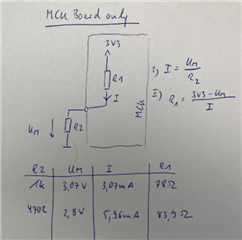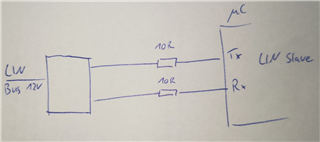Other Parts Discussed in Thread: HALCOGEN
Hello,
I am using the TMS570LS1224 with the TMS570x Launchpad and have some issues with the LIN Rx Pin of the µC.
If we connect the LIN Tx and Rx to a LIN Transceiver, and have a LOW signal on the 12V bus wire, we get a LOW signal on the Rx pin of 2.0V. The HIGH signal is fine on 3.3V.
I suspected a wrong configuration of the LIN Block.
I read out the LIN config with the halcogen function "linGetConfigValue(®, CurrentValue)" see following screenshot of the LIN config registers.

Register GCR1 says: LIN mode enabled (bit 6) and LIN slave mode (bit 5)
Register FUN/PIO0 says: LINRX is the receive pin (bit 1), LINTX is the transmit pin (bit 2)
Registers seems to be configured correctly for me.
After that I analyzed to LIN RX port on the Evalboard standalone. No mather of the configuration (pull up, pull down, open, input, output, gio, lin) it seems that the RX input is pulled high with a 80R equivalent. I verified that with the following testsetup. As you can see, the calculated currents are very high, whereas the datasheet mentions only 20µA (Data Sheet TMS570LS1224 chapter 4.3.1.8 LIN)

So far my investigations on the above described LIN input behaviour I found on three evaluation boards.
Please give me some assistance to solve this issue.
Thanks
Daniel


